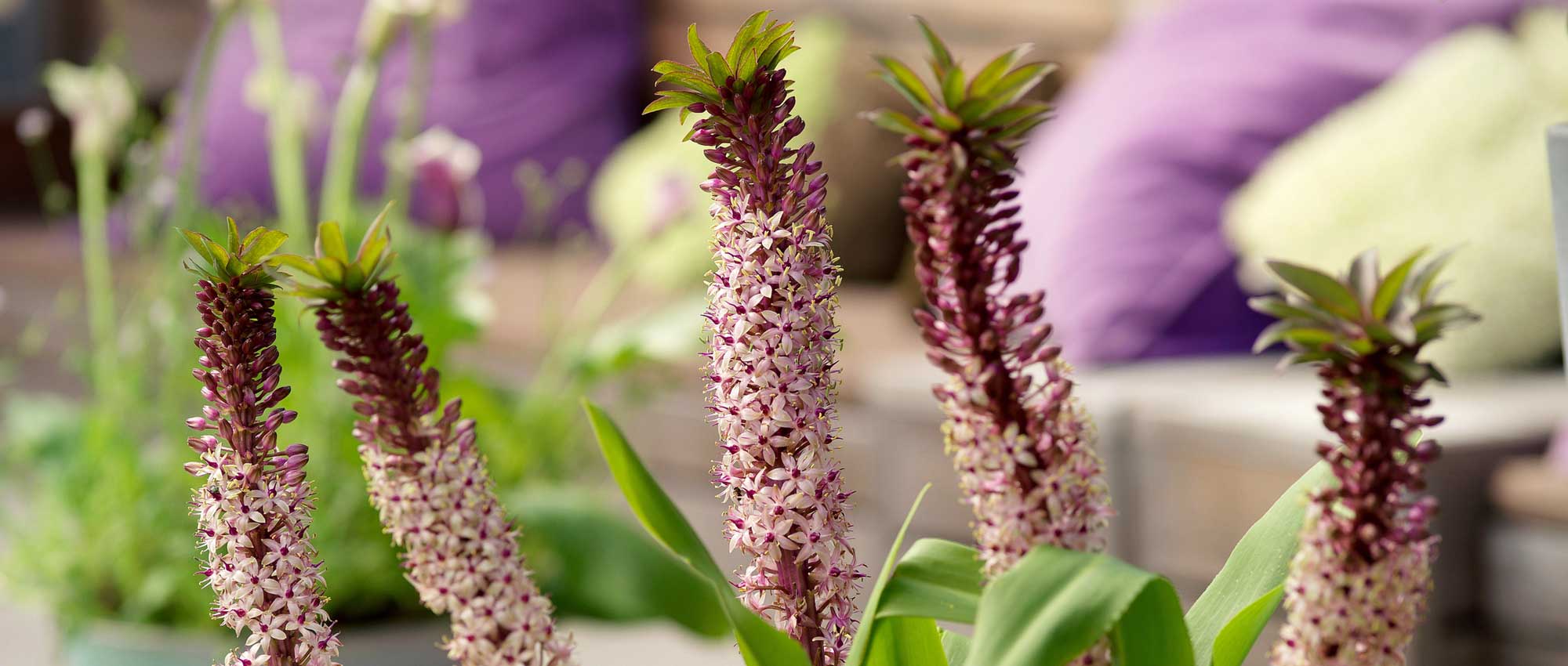
Eucomis or pineapple lily: planting, growing and care
Contents
Eucomis in a nutshell
- Eucomis is a bulbous plant that offers a surprising and exotic flowering, reminiscent of the shape of pineapple
- The shades of the flowers are both soft and warm!
- The often lush foliage sometimes takes on beautiful purplish or burgundy colours
- It is a plant with an exotic look that is quite easy to grow and propagate!
- It requires a well-drained, warm, and sunny position, moderately hardy
A word from our Expert
Eucomis is a lovely bulbous plant from South Africa that brings a lot of exoticism to borders in summer. Known as “Pineapple flower”, it has a whimsical, slightly strange quality, with inflorescences shaped like pineapples… especially since it is a plant that is rarely found in gardens. It has everything to spark curiosity! Although it is easy to care for, it is unfortunately too little known and seldom grown… In gardens, you mainly find the species Eucomis bicolor, comosa and autumnalis, as well as the varieties derived from them. Eucomis are unique both for the shape of their inflorescence and their colours (for example, greenish, pale yellow, or purplish, actually blending several shades), and for their foliage, especially when they are purple.
Eucomis is an exotic plant with relatively low hardiness. If your climate is temperate and you live along the Atlantic coast, the Mediterranean region, or the English Channel, it can remain in the ground during winter; elsewhere, it will need protection with mulch or to be overwintered. Planting takes place in spring, in a sunny location. Eucomis is easy to grow and is rarely affected by diseases or pests. Preferring moist conditions, it mainly requires regular watering in summer. It propagates quite easily by sowing, propagation by cuttings, or division.
Botany
Botanical data
- Latin name Eucomis sp.
- Family Asparagaceae
- Common name Pineapple flower, Eucomis
- Flowering summer
- Height between 30 and 70 cm
- Exposure full sun
- Soil type well-drained, fertile
- Hardiness often down to -7 °C, sometimes lower.
The Eucomis is a bulbous perennial plant, primarily originating from South Africa. It is also known as Pineapple flower, or sometimes Pine lily. The Eucomis genus comprises 11 species. The most commonly cultivated is Eucomis bicolor, but Eucomis comosa and autumnalis are also grown. They are appreciated for their originality and very exotic appearance, with their flowering resembling the shape of a pineapple. Eucomis can be found in nature, particularly in wet meadows, along riverbanks, at forest edges, or in rocky scree areas…
The Eucomis belongs to the Asparagaceae family, but was previously classified among the Liliaceae. Although it is called Pineapple plant, the eucomis is quite distant from the pineapple, which belongs to the Bromeliaceae family.
Etymologically, the name Eucomis comes from the Greek eu: good, and kome: hair, which could be translated as “beautiful hair,” referring to the tuft of bracts that crowns the inflorescence.
The Eucomis typically measures between 30 and 70 cm in height. The species Eucomis vandermerwei is much smaller, reaching only 15-20 cm in height, while Eucomis pole-evansii can reach 1.80 m when in bloom! The Eucomis forms clumps of leaves, from which a flowering stem emerges. This stem is hollow, thick, and fleshy, often spotted with purple (notably in Eucomis bicolor). It can also be entirely purple, as seen in the variety ‘Sparkling Rosy’.
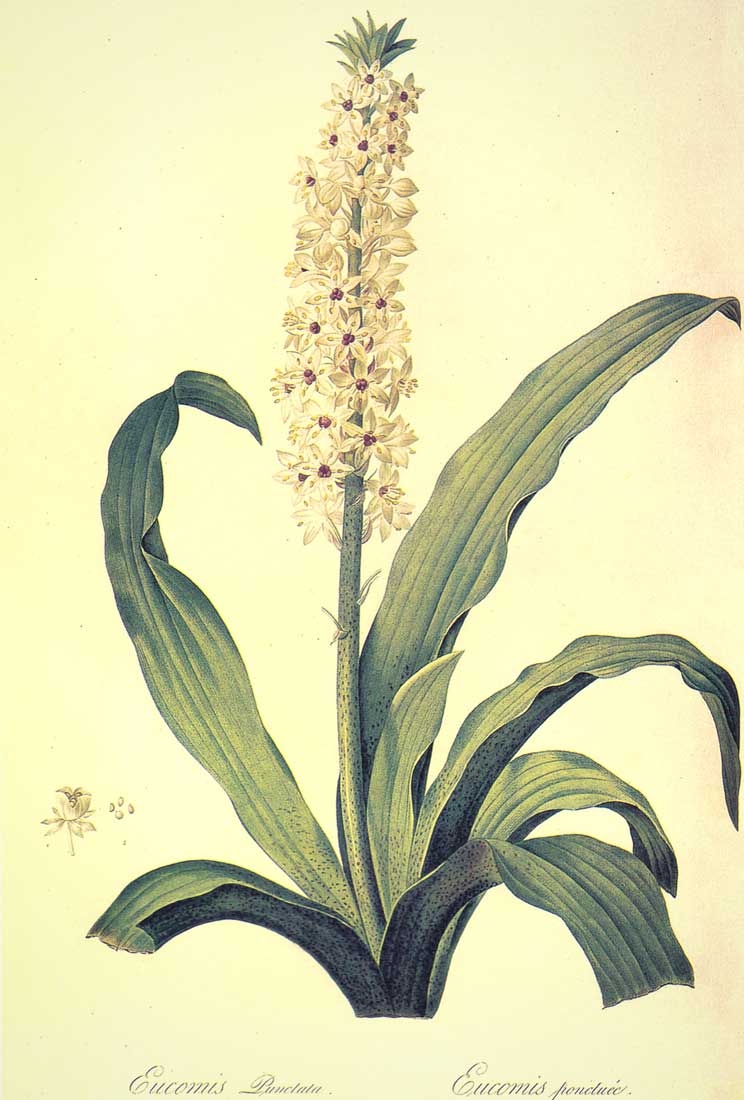
Eucomis comosa: botanical illustration
The Eucomis flowers in mid to late summer, around September, and sometimes as early as July. The flowering lasts quite a long time, between several weeks and three months. The flowers also have good vase life.
The flower spikes emerge from the centre of the leaf rosette. The Eucomis offers a beautiful upright, unbranched flowering display, measuring between 10 and 30 cm long. The inflorescences consist of numerous small star-shaped flowers, densely packed together. The flowering has a massive, voluminous appearance, with a very straight, robust, and thick flower stem. The spikes are quite slender and elongated in Eucomis comosa. They are much shorter in Eucomis vandermerwei. A flower spike typically contains between 100 and 130 flowers, which open from the bottom upwards.
Each flower measures between 1 and 3 cm in diameter and consists of six tepals (undifferentiated sepals or petals), fused at the base, surrounding six stamens. At the centre, the globose ovary with three angles is clearly visible.
The flowering can be pale yellow, white, purple, pink, or greenish… The hue is not bright, vivid, or pure, but rather “broken,” nuanced, as the spike is composed of many small bicoloured flowers that, from a distance, give the impression of a shade lying between two colours: for example, pale yellow and purple at the same time… The hue is, however, a bit more vivid in the pink flowers of Eucomis ‘Twinkle Stars’ or ‘Pink Gin’. Sometimes, the flowers change colour after fertilization (for instance, turning green in Eucomis autumnalis)!
As its name suggests, Eucomis bicolor bears flowers that combine two shades: the petals are pale yellow, slightly greenish, edged with a delicate purple border. The stamens are also purple.
The inflorescence is topped by a tuft of bracts, resembling true leaves, which gives it the name Pineapple flower. The outline of these bracts is sometimes beautifully highlighted by a fine purple border (if the plant is in the sun; in shade, this coloration does not always appear). Some varieties have a rather small and discreet tuft of bracts, such as ‘Burgundy Wine’ or ‘Sparkling Rosy’.
The flowers have a slight unpleasant odour to attract the flies that ensure their pollination.

The flowering of eucomis! From left to right, Eucomis comosa (photo Jean-Michel Moullec), Eucomis vandermerwei, and Eucomis ‘Sparkling Rosy’ (photo Wouter Koppen – iBulb)
The Eucomis bears a basal rosette of very elongated, glossy, and fleshy leaves. They are described as ribbon-like (in the shape of a ribbon). They measure between 30 and 50 cm long, sometimes even up to 70 cm. Many species have leaves with edges that are more or less undulate. This character is very pronounced in Eucomis vandermerwei! The fleshy appearance of Eucomis leaves allows for cuttings to be made from segments of the lamina. The foliage is quite dense and voluminous, with numerous leaves. They all emerge from the base of the plant and are arranged around the flowering stem, forming a central axis.
The leaves are often green but can also appear, in some varieties, in shades of purple. In ‘Sparkling Burgundy’, they have a beautiful burgundy hue. Eucomis vandermerwei has surprisingly spotted foliage… which adds even more originality to the plant! It is quite common for the base of the leaves to be purple. The purple hues of Eucomis are even more pronounced when planted in full sun. In Eucomis schijffii, the foliage is bluish, broad, and rather rounded.
The leaves are deciduous. The plant completely disappears at the end of autumn, reappearing in spring.
The Eucomis has a bulb, an organ that allows the plant to store nutrients and survive the winter underground. Bulbs with a large calibre produce more beautiful and generous blooms.
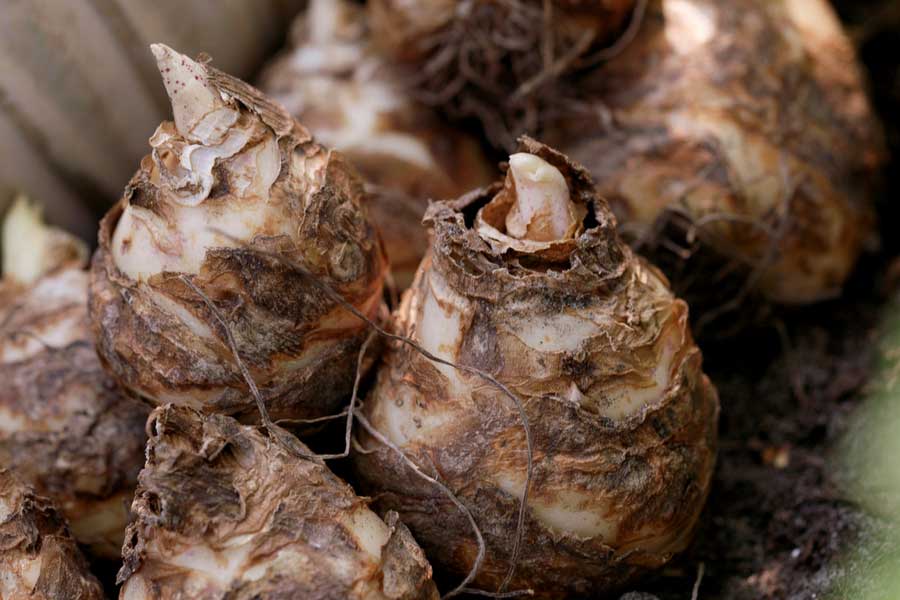
The bulbs of Eucomis (photo Steven Bemelman – iBulb)
Even after flowering, the eucomis remains decorative thanks to its fruits, which appear on the flower spikes. These are three-angled capsules that release shiny, round brown seeds.

The fruits and seeds of Eucomis bicolor (photos H. Zell)
Despite its South African origin, the Eucomis is a relatively hardy plant. It can withstand temperatures down to -7 °C, and even down to -15 °C for some varieties if they are protected (notably with mulching, and by being planted quite deeply…). However, it is advisable to be cautious of severe frosts. The Eucomis bicolor is among the hardiest.
The main varieties of Eucomis
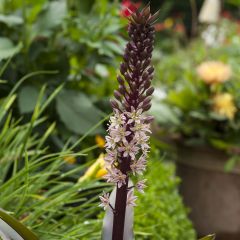
Eucomis comosa Sparkling Rosy - Pineapple flower
- Flowering time August to October
- Height at maturity 70 cm

Eucomis Burgundy Wine - Pineapple flower
- Flowering time October
- Height at maturity 40 cm

Eucomis autumnalis - Pineapple flower
- Flowering time September to November
- Height at maturity 60 cm
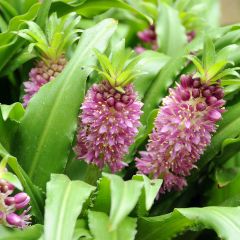
Eucomis comosa Sparkling Burgundy - Pineapple flower
- Flowering time August to October
- Height at maturity 70 cm
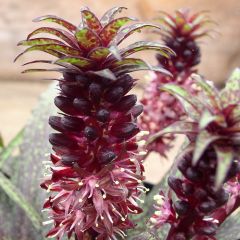
Eucomis vandermerwei - Pineapple flower
- Flowering time August to October
- Height at maturity 20 cm

Eucomis Playa Blanca - Pineapple flower
- Flowering time August to October
- Height at maturity 50 cm

Eucomis pallidiflora subsp. pole-evansii - Pineapple flower
- Flowering time August to October
- Height at maturity 1,50 m
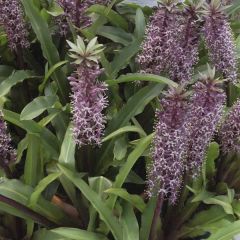
Eucomis humilis Twinkle Stars - Pineapple flower
- Flowering time August to October
- Height at maturity 60 cm
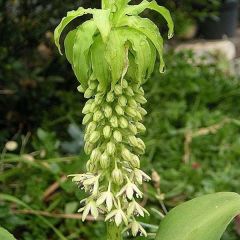
Eucomis bicolor Alba - Variegated pineapple lily
- Flowering time October
- Height at maturity 40 cm
Discover other Eucomis
View all →Available in 0 sizes
Available in 3 sizes
Available in 1 sizes
Available in 1 sizes
Available in 1 sizes
Available in 1 sizes
Available in 1 sizes
Available in 2 sizes
Available in 1 sizes
Available in 1 sizes
Planting
Where to plant?
Plant the eucomis preferably in full sun, possibly in partial shade. The eucomis with coloured foliage, such as Eucomis ‘Sparkling Burgundy’, display more vibrant colours when in sunlight.
It is important that the substrate is well-draining, to prevent the bulb from rotting due to excess moisture. Feel free to improve drainage with coarse sand or small gravel before planting. However, eucomis appreciate soils that remain cool during the growing season, especially in summer.
Eucomis are quite hungry plants; they thrive in soils rich in organic matter. Plant them in light, loose, and sufficiently deep soil. They are fairly tolerant of pH levels. If possible, place the eucomis sheltered from the wind.
Eucomis can be easily grown in pots. This is preferable if you live in a very cold region, as it allows you to bring them indoors easily during winter. They also adapt well to cultivation in a cold greenhouse.
Eucomis are perfect for integrating into borders alongside other perennials, but they also suit planting at the edge, for example, to highlight a pathway. Some species, such as the small Eucomis vandermerwei, can be beautifully placed in rockeries.

You can plant eucomis in pots (Eucomis bicolor, photo Wilfried Overwater – iBulb) or in the ground (Eucomis pole-evansii, photo Megan Hansen)
When to plant?
We recommend planting the Eucomis in spring, around April or May, as soon as there is no longer a risk of frost. In milder regions where frosts are absent, you can plant them from February.
How to plant?
Eucomis should be planted quite deeply, 15 to 20 cm below the soil level. This provides extra protection against the cold. Preferably plant the eucomis in groups of at least three or five bulbs, spacing them about 30 cm apart each time.
- Start by preparing the ground. Add compost or well-rotted manure, coarse sand or gravel to improve drainage, and possibly a bit of potting soil.
- Dig a hole about twenty centimetres deep.
- Plant the bulb, ensuring the tip is facing upwards.
- Fill in the planting hole and firm down.
- Water generously.
For pot planting:
- Choose a sufficiently large container (between 20 and 30 cm in diameter).
- Place a drainage layer at the bottom: gravel, broken pot pieces, clay balls…
- Plant in a well-draining substrate (for example, a mix of garden soil, potting soil, and coarse sand). You can plant several bulbs in the same pot.
- Cover them.
- Water thoroughly.
- Place the pot in the sun.
Care
The substrate should remain moist while the plant is in growth. Water regularly in summer (up to twice a week, allowing the substrate to dry out between waterings). Reduce watering in winter, as the plant is in dormancy and the bulb may rot. In pots, watering should be slightly more frequent than in the ground, as the substrate dries out more quickly. However, be careful not to leave standing water in the bottom of the pot.
Eucomis will appreciate a application of well-decomposed compost in spring. You can place it at its base, around the clump, and lightly scratch the soil to incorporate it into the surface. If you are growing eucomis in a pot, you can apply a bit of liquid fertiliser every two to three weeks, or simply add some compost to the surface in spring and lightly incorporate it. This will encourage beautiful flowering!
We recommend dividing them from time to time to rejuvenate the clumps and prevent them from becoming exhausted. Do this approximately every three years.
When they have faded, you can choose to cut the flower stems, but we advise leaving them in place, as the capsules that form afterwards are also decorative.
As Eucomis is a deciduous plant that completely disappears in winter and only reappears late, it is best to mark its location, for example with a small stake or a label.
Protection against cold:
Eucomis is a moderately hardy plant. It can remain in the ground in winter in relatively mild regions, but if you live in a rather cold climate, it is better to protect them. There are several options for this:
- If it is planted in a pot, simply bring it indoors for the winter.
- If it is in the ground, you can apply a good layer of mulch in autumn, made up of dead leaves, for example.
- Alternatively, you can dig up the bulbs and store them in a dry, airy place at a temperature between 7 and 10 °C. You will replant them in spring, as soon as the risk of frost has passed.
Eucomis is rarely affected by diseases or pests. It may occasionally be attacked by slugs that nibble on its leaves in spring. Also, be cautious of excess moisture, especially in winter, as the bulb is susceptible to rotting.
Propagation
Eucomis can be propagated by sowing, propagation by cuttings of leaves, or division.
Sowing
Eucomis are quite easy to propagate by sowing. This operation is preferably carried out in spring, around April or May. It is also possible to sow in autumn.
- Take a pot and fill it with well-draining, sandy substrate.
- Sow the seeds.
- Lightly cover them. They should be buried under about 5 mm of substrate.
- Water gently.
- Place the pot in a bright location at a temperature of around 20 °C.
Germination occurs after 4 to 6 weeks. When the young shoots are sufficiently developed, you can transplant them into individual pots. Eucomis obtained from sowing take between three and five years before they start to flower.
Propagation by cuttings of leaves
Eucomis have the unique ability to be propagated from segments of leaves. Preferably use a sharp, disinfected knife.
- Prepare pots with a well-draining substrate, such as a mix of potting soil and sand.
- Water to ensure the substrate is well moist.
- Take a whole, healthy leaf in good condition, then cut it into several segments of six or seven centimetres in length.
- Plant them in the substrate, vertically and in the correct orientation (in the same direction they were growing on the plant). The base should be buried 1.5 to 2 cm deep.
- Place the pots in a warm location (around 20 °C), and ensure the substrate remains moist until the cutting begins to grow. Ideally, cover the pot with a plastic bag to maintain a humid atmosphere (in a mini greenhouse effect). Ventilate occasionally to prevent the onset of diseases and fungi.
Division of clumps
You can divide your eucomis in early spring, every three to four years. This will help rejuvenate your plants. As this operation is carried out while they are still in dormancy, it is best to have previously marked the location of the bulbs.
Start by carefully digging up your eucomis, digging wide enough around to avoid damaging the root system. Remove the excess soil, then separate the bulbs by cutting them with a sharp, disinfected knife. Replant them in a new location and water.
Association
Eucomis pairs wonderfully with other exotic plants! Plant it alongside agapanthus, crocosmias, cordylines, and phormiums. Combine the surprising flowers of kniphofias with the unique appearance of Eucomis! Add large, voluminous foliage (banana plants, palms, arborescent ferns…). Also, discover the stunning dissected foliage of Datisca cannabina.
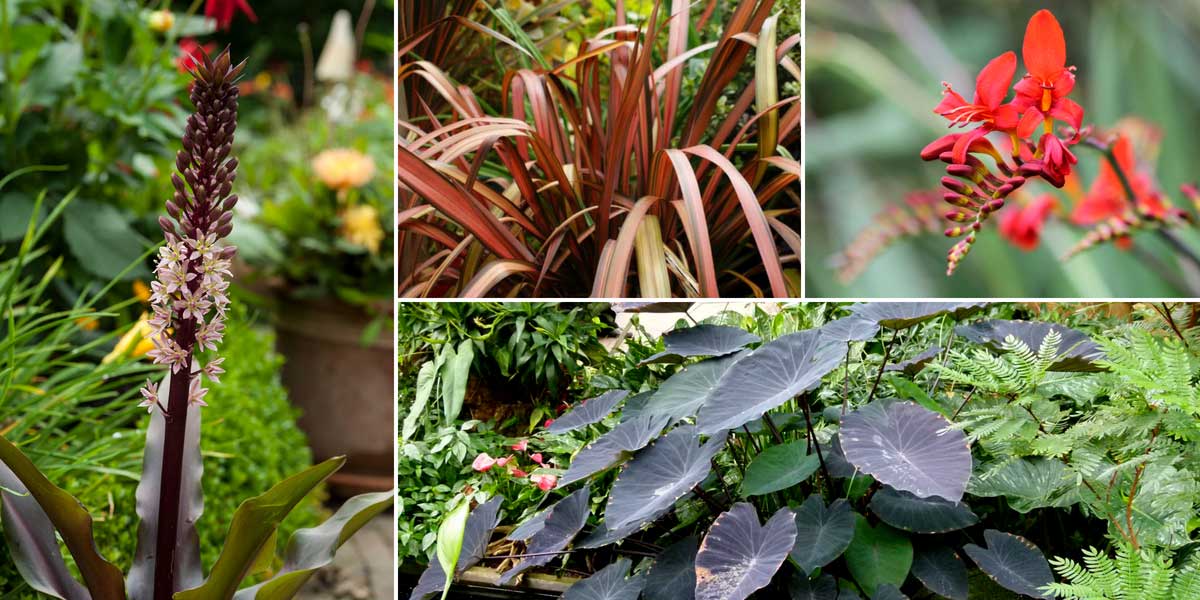
Eucomis is perfect for accompanying other exotic-style plants! Eucomis ‘Sparkling Rosy’ (photo Wouter Koppen – iBulb), Phormium ‘Pink Panther’, Crocosmia, and Colocasia ‘Black Magic’ (photo J. Rebel)
You can integrate eucomis into a modern-style garden, alongside graphic plants with very straight lines, for example with other plants featuring upright flower spikes (kniphofia, etc.). Opt for purplish, chocolate, dark hues… Original and warm colours! Also, bring contrast with some white flowers, and create structural effects with trimmed plants (box, yew…) with which you can draw curves or waves. Introduce movement and lightness with the flower spikes of grasses, with Gaura lindheimeri, or with Buenos Aires verbena.
Do not hesitate to create a bed featuring original and uncommon plants in gardens! Create a surprising garden by associating eucomis with Hedychium, Scadoxus multiflorus, Sprekelia formosissima, Tropaeolium tuberosum (tuberous nasturtium) or Galtonia viridiflora (Cape hyacinth)… Also, discover the stunning bright red flowering of Lycoris radiata! And the elegant flower spikes of the giant Himalayan lily, Cardiocrinum giganteum!
Eucomis can also find its place in a rockery that remains relatively cool in summer. For example, install Eucomis vandermerwei, with wall bellflowers, spurges, Geranium sanguineum, and Erigeron karvinskianus. Prefer plants with a spreading or cushion habit, which will nestle between large stone blocks. Also, scatter some tufts of grasses to add volume and lightness!
You can also simply place eucomis in a perennial bed, for example with flowers in warm tones, such as dahlias, crocosmias, coreopsis, or echinaceas. Also, enjoy the beautiful, very bright flowering of Acidanthera or Abyssinian gladiolus. You can integrate Verbascum for their tall yellow flower spikes, which will also bring structure and height.

Two examples of pairing with eucomis to play with colours! Eucomis ‘Sparkling Burgundy’ and dahlias, eucomis and begonias. (photos Steven Bemelman – iBulb)
Useful resources
-
- Discover our range of Eucomis!
- Find our ideas for pairing Eucomis.
- Discover our tips for growing Eucomis in pots
-
- Get inspired by this exotic atmosphere to pair Eucomis!
- To discover: green flowers!
Frequently asked questions
-
The leaves of my eucomis are being nibbled! What should I do?
The culprits are slugs, which enjoy the young leaves of eucomis in spring. You can make a slug trap, create a barrier with ash or wood chips, or use a slug repellent such as Ferramol.
-
My eucomis isn't flowering!
If obtained from sowing, it can take a few years, sometimes up to five years, before the eucomis starts flowering! You simply need to be patient while the plant gets well established. We advise you to avoid overly nitrogenous fertilisers, which promote foliage at the expense of flowering. Choose a slow-release fertiliser that is slightly richer in phosphorus and potassium. Finally, ensure that the growing conditions are suitable: eucomis thrives more easily in sunlight, and it does not like summer drought!
- Subscribe!
- Contents
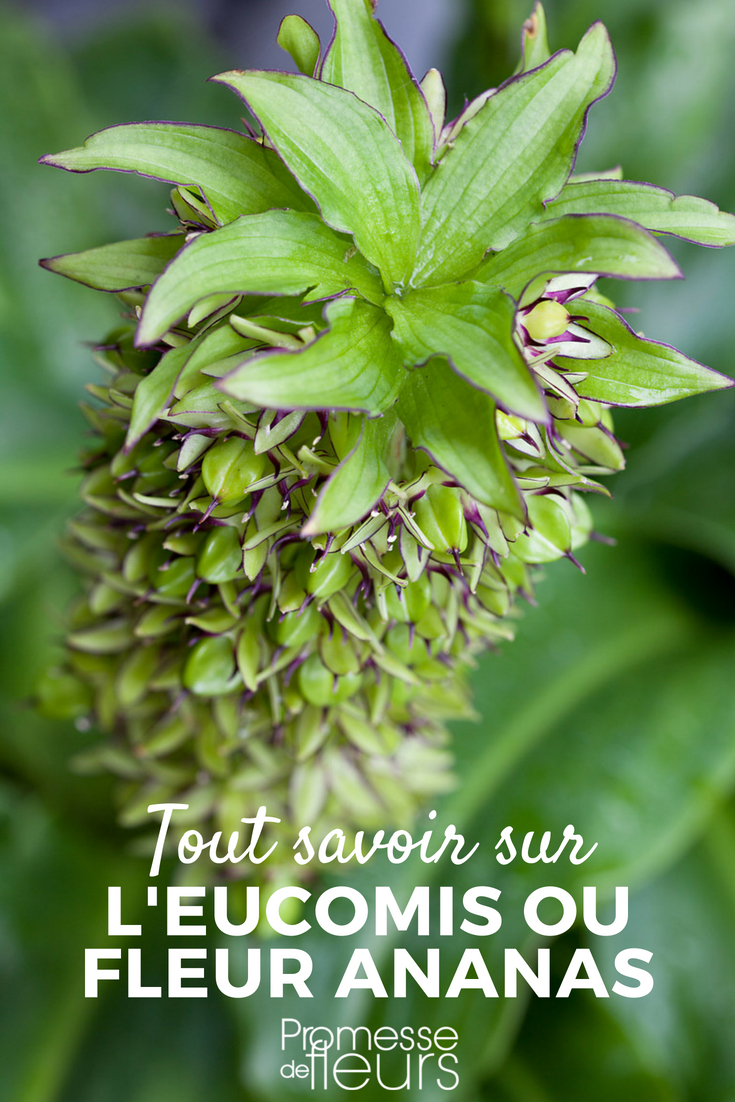































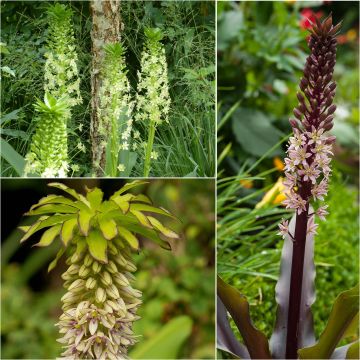
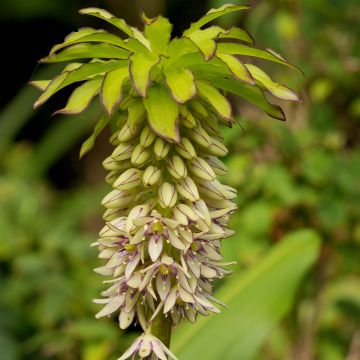

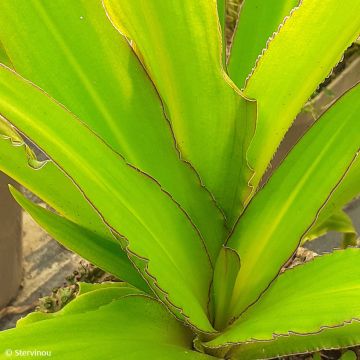
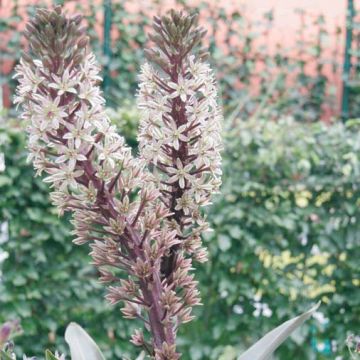
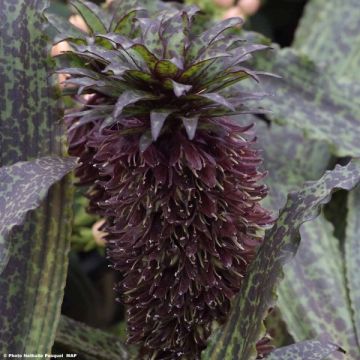
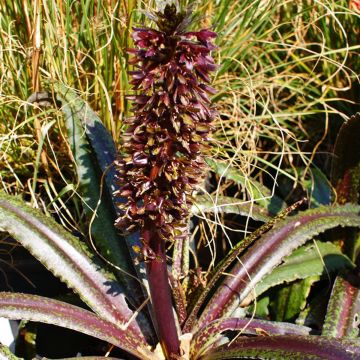

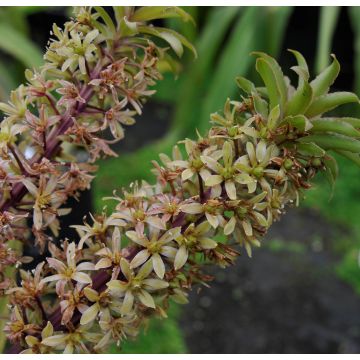

Comments